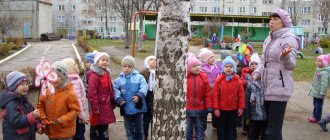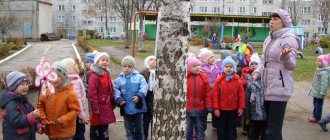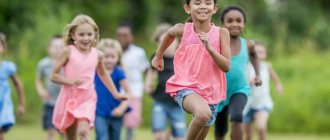For the correct and harmonious development of a child’s personality, it is necessary not only to develop methodological work in drawing, modeling, and dancing groups, but also to take a daily walk in the middle group of the kindergarten.
In addition to outdoor activities, children need to be provided with a lot of information about the world around them.
During the change of four seasons, children in the middle group need to be shown how nature changes. There is an opportunity to visually discuss and observe insects, animals, plants and other changes in nature and the surrounding world.
Observation walks
According to the Federal State Educational Standards of the register of educational programs, there are certain regulatory data, based on which it is necessary to compile (prospective planning) files of walks and observations with specific goals for the development of the child’s personality in the middle group of a preschool educational institution:
- Observations of natural phenomena with children. On each specific walk, find out with the children what day is sunny or cloudy. Determine whether there is precipitation today, whether it is windy or calm. Children should be able to distinguish between rain, snow, hail or frost. A targeted evening walk to study the starry sky is possible.
- observation of transport during your walk and analyze when cars look cleaner - on a rainy and slushy day or on a dry and sunny day.
- Observing the plant world is a very interesting and educational activity for kids. Throughout the year, daily walks provide a great opportunity to follow plants, trees, flowers, buds, and leaves. The time of winter, when the trees sleep, then spring - awakening from sleep, swelling of the buds, appearance of tender foliage. Bright summer with a palette of colors, then golden autumn with elegant leaves on the trees.
- While on walks, children can easily and simply observe various insects: chafers, dragonflies, mosquitoes. Monitor behavior, manner of movement, lifestyle.
- On walks you can also observe the animal world: cats, dogs, birds.
Lesson summary for the middle group “Autumn walk”
Lesson summary for the middle group “Autumn walk”
Educator: Sinyakova I.V.
Goals:
introduce children to the main signs of autumn: cooling, change in color of leaves on trees, falling leaves, frequent rains. Introduce the general concept of “season”. Introduce the name of the trees growing on the territory of the kindergarten. Enrich children's vocabulary.
Preliminary work:
looking at an album with pictures of trees, leaves and fruits.
Materials:
toy hare, colored pencils, A4 sheet of paper.
Progress of the lesson:
Educator: Dear children. Today we will go for a walk with the bunny. Now I will introduce you. Meet this bunny, and his name is Forget. He often forgets everything. And I would like to get to know all the trees that grow in our kindergarten. Does everyone know how to get acquainted?
Forgetful Bunny: Oh, did I forget?
Educator: Children, let's remind the bunny.
Children: Yes. First we say hello, say our name, then ask what their name is.
Forgetful Bunny: I'll try to remember. (Meet the children). Do you think trees can talk?
Children: no
Forgetful Bunny: So what should we do? How do we know the name of each tree?
Educator: Don’t worry, bunny, I understand the language of trees a little, and I will introduce you.
We approach the first tree, a birch.
Educator: And here is the first tree. Let's say hello. Who will be the first to meet? Or did you recognize this tree?
Children: found out it’s a birch tree.
Educator: Well done. How glad she is that you recognized her. Birch recognizes you all every morning; you walk past her to kindergarten. This is how joyfully its leaves rustle.
Forget the Bunny: Hello birch, and I am the Forget Bunny. What a beautiful trunk it has, white with black stripes. But, something happened, why are some of the leaves on the ground? And why did they turn yellow?
Children: Because autumn has come.
Forgetful Bunny: Autumn. Oh, what is autumn?
Educator: Autumn is the time of year. Guys, tell Zabyvayka what signs of autumn do you know and after what time of year does autumn come?
Children's answers (the leaves turn yellow and fall off, it becomes cold, cold rains often fall; autumn comes after summer).
Forgetful Bunny: How smart you are. When I return home to my mother, I will definitely tell her.
We approach the second tree, a pine.
Educator: This tree is called pine. Let's say hello too.
Forget the Bunny: Hello pine, I'm the Forget Bunny.
Children also say hello to the pine tree.
Forgetful Bunny: Why are there no leaves on the pine tree, but only needles? Maybe it's not a tree at all?
Educator: What about the bunny? A pine tree has both a trunk and branches. And instead of leaves it has needles; they do not turn yellow or fall off in the fall, but remain green. There is even a riddle about the pine tree:
Winter and summer in the same color
Forgetful Bunny: I’ll definitely remember.
Third tree, rowan.
Forgetful Bunny: And here, some kind of berries?
Children: this is a rowan.
Educator: Correctly, this tree with beautiful, red berries is called rowan.
Bunny Forget: A very beautiful name Rowan and its leaves are not yellow, but red.
Educator: Children, together with Forget, let’s say hello to the mountain ash.
Children and bunny: Hello rowan.
Educator: Forgetful, all children know how to be friends with trees.
Children are told that they should not harm trees: break branches and tear leaves from the branches.
Educator: Trees are very useful, they purify the air, provide shade and coolness in the summer when it’s hot, animals and birds feed on tree seeds. Birds also build their nests in trees. And how beautiful it is in our kindergarten territory. Especially in the fall. When the leaves of the trees turn different colors.
Forgetful Bunny: How many interesting things I learned today. But, somehow, I already want to run. Guys, let's play my favorite game “Who runs faster?”
P/i “Run to the birch tree”
goal: to develop motor activity
move: at the teacher’s signal, the children must run to the birch tree, the one who first reached the indicated tree wins.
Educator: Well, now let's collect the fallen leaves into piles, and give the brightest and most beautiful ones to the Forgetful Bunny. He will dry them, remember autumn and from which tree these leaves fell.
D/i “Whose sheet?”
Goal: to consolidate knowledge about some trees, to teach how to determine by a leaf which tree it belongs to
Progress: Children bring leaves and name what tree they come from.
Educator: Well, bunny, let us check you to see if you remember all the names of the trees we introduced you to.
The bunny names the names of the trees. Children praise the bunny Forget.
Forgetful thanks the guys and leaves.
Educator: Did you like the walk with the bunny Forget?
Children: I liked it.
The teacher asks each of the children what specifically they liked or remembered during the walk.
Educator: Come on, when we return to the group, you will draw what exactly you liked.
Planning walks in the middle group according to the Federal State Educational Standard
Let's look at the file of observation walks for the middle group of preschool educational institutions. In order for the walks to be interesting and at the right pace, it is necessary to draw up a plan and preliminary preparation on various topics.
Walk 1 – Autumn Tree Watching
Goal: learn to find distinctive features of trees in autumn compared to summer. To see extraordinary beauty in the autumn colors of trees.
Progress of observations: read the poem by A. S. Pushkin “Dull Time”.
Observe different trees with children. Find differences and similarities in the color of autumn leaves of oak, maple, birch, and rowan. Draw children's attention to the special beauty of the entire landscape in autumn, September, October, November.
Experience, experiment: collect beautiful autumn leaves for crafts on an autumn theme.
Outdoor game: competition with autumn fruits. Divide the children into two teams. Give each person one acorn (to the first team) and one chestnut (to the other team). From the beginning of the game, children from each team simultaneously run a race with their acorn (chestnut) to the marked place and throw it into the bucket. Those who run faster win. Physical exercise and reaction to speed will charge children with vigor and fun.
Walk 2 - Watching Snow During the Winter Months
Goal: learn to observe changes in nature in winter.
Progress of observations: note if snowfall means warming. Snowflakes crunch underfoot - frost. In winter it gets dark early - especially in December. In winter comes New Year and Christmas. Children sled, skate, ski, and play snowballs.
Experience, experiment: carrying out an analysis - measure the depth of a snowdrift in the sun and in the shade, offer independent activity to the baby.
Outdoor game: snowball fight. An active, cheerful game will warm children, give them a good mood, and teach them accuracy.
Walk 3 - watching a cat in the spring area of the garden
Goal: remember the characteristic signs of a cat, its habits, behavior.
Progress of observations: read a poem about a cat, ask a riddle and ask which of the children knows poems about cats. Invite children to examine and describe the cat and its distinctive features. Talk about how spring affects cats (they become goulens). That with the arrival of spring, the cat's fur sheds lighter for the summer period. Build a dialogue with children in the form of a conversation.
Experience, experiment: try to play with a cat using a ribbon on a string. Warn children that they should not pick up unknown animals on the street.
Outdoor game: conducting physical education. Jumping on two legs while moving forward. Moving exercises have a beneficial effect on muscles.
Walk 4 - observing flowers and insects in the flower beds in summer
Goal: find out how summer differs from other seasons. A thematic walk near flowering flower beds, carrying out a walk according to the planned outline.
Progress of observations: what flowers bloomed in the flowerbed, ask who knows what they are called, how the flowers differ from each other. Observing bees - how they pollinate flowers. Tell them how important their work is in nature. Ask children what insects they know, identify their differences and benefits for nature.
Experience, experiment: personal work: water flowers in flower beds from a watering can, telling children about the importance of watering plants.
Outdoor game: “Run to the flag.” Teach children to perform actions when signaled by the teacher. Quickly move to the flag and return back.
Planning walks for children in the middle group of kindergarten is a very significant moment in development. Observation walks have a huge positive effect on the entire children's team as a whole.
Walk for children of the middle group “Autumn time”
Authors:
Milnichenko Tatyana Vasilievna,
Muslimova Liliya Rubilevna
educators
MADOU d/s No. 133, Tyumen
Target:
Summarize the signs of Autumn with your children. To foster cognitive interest in nature, to develop speech development in children. The desire to be in the fresh air, to learn to notice the beauty of nature. Loving her, trying to protect her from trash, learning to take care of her.
Objectives: - Help consolidate knowledge about trees, learn to identify trees by their characteristics, learn to distinguish the leaves of different trees; - Develop children's speech. — Enrich your vocabulary. - Train memory and attention. — Form a holistic picture of the natural world. — Foster concern for the environment.
Preliminary work:
Observing autumn nature, looking at trees, learning poems about autumn, reading works of art. Examination of a reproduction of Levitan’s painting “Golden Autumn”, as well as sketches and illustrations depicting various trees in autumn, collecting leaves on a walk.
Progress of the walk
If the leaves on the trees have turned yellow, If the birds have flown to a distant land, If the sky is gloomy, if the rain is pouring, This time of year is called autumn. Author: M. Khodyakova.
Observation:
Remind children that autumn has come. The whole ground was covered with leaves - everything around was yellow. That's why autumn is called yellow and golden. Draw the children's attention to how one leaf flies to the ground, the other spins, spins and slowly falls to the ground. Clarify that the leaves are light, so they fly to the ground slowly. The wind blew, and many leaves rustled to the ground - this is leaf fall.
Look at the leaves of different trees. Please note that the surface of the leaf blade varies from tree to tree.
Outdoor game "Falling Leaves"
The goal is to consolidate children’s knowledge about the color and size of autumn leaves. Reinforce the concept of “leaf fall.” Progress of the game. Children choose a leaf for themselves and name which leaf they chose based on size and color. Children run and wave their arms:
Leaf fall! Leaf fall! Yellow leaves are flying. (children with yellow leaves)
Leaf fall! Leaf fall! Red leaves are flying! (children with red leaves)
Beautiful yellow leaves are spinning! (children with yellow leaves)
Beautiful red leaves are spinning! (children with red leaves)
They sat down, sat down and froze.
A light breeze came and blew.
Leaves rose and scattered in different directions.
Spinning, spinning.
Leaf fall, leaf fall! Leaves are flying in the wind!
Outdoor game “ Run to the named tree.”
Goal: to train in quickly finding the named tree.
Progress of the game: The driver is selected. He names a tree, all children must listen carefully to which tree is named and, in accordance with this, run from one tree to another. The driver carefully monitors the children; whoever runs to the wrong tree leaves the game.
Sedentary game "Leaves"
Leaves are falling, falling - (Children are spinning, raising their arms up, squatting)
It's leaf fall in our garden. Yellow, red leaves (Spin again)
They curl and fly in the wind. Birds are flying south - (Running in a circle, waving their arms)
Geese, rooks, cranes. Now the last flock is flapping its wings in the distance.
Guys, let's collect colorful leaves to make a beautiful panel out of them to decorate the group. (Children and their teachers collect leaves, discussing their color, shape and from which tree they fell).
Educator: Guys, what beautiful leaves you have. You liked the walk, you would like to come here again (children's answers). Unfortunately, it's time for us to go, well done to you all!
List of used literature:
1. Teplyuk S.N. Walking exercises in the middle group. For working with children 3-4 years old. M.: -Mosaika-Sintez, 2010
2. Ulanova L.A., Jordan S.O. Methodological recommendations for organizing and conducting walks for children 3-7 years old. – SPb.: “CHILDHOOD-PRESS”, 2008
3. Author: M. Khodyakova poem “Autumn Leaves”
We invite teachers of preschool education in the Tyumen region, Yamal-Nenets Autonomous Okrug and Khanty-Mansi Autonomous Okrug-Yugra to publish their teaching materials: - Pedagogical experience, original programs, teaching aids, presentations for classes, electronic games; — Personally developed notes and scenarios of educational activities, projects, master classes (including videos), forms of work with families and teachers.
Why is it profitable to publish with us?
1. “Kindergartens of the Tyumen Region” is an officially registered specialized media outlet at the federal level. 2. The activities of the editorial office are supported by the Department of Education and Science of the Tyumen Region 3. We issue a “Certificate of Publication” in the media. 4. The document has a unique number, is entered in the register, has the original seal of the editorial office of the online publication and signature. 5. “Certificate of publication” in the media is sent to the author in both paper and electronic versions.
Details >>>
Sample “Certificate of publication of author’s methodological material in the media.”pdf
Share





